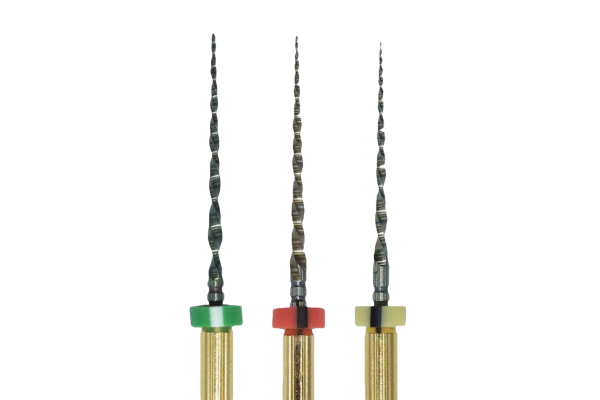EdgeEndo®
Find out how EdgeEndo files can save your practice money and perform as well as your current files.

Find out how EdgeEndo files can save your practice money and perform as well as your current files.

Founded by an endodontist, EdgeEndo’s mission is to deliver high-quality dental products and solutions for clinicians and patients everywhere. Innovation is at the heart of EdgeEndo, and that ethos is clear in the wide range of products on offer, especially in the files featuring EdgeEndo’s revolutionary heat-treated NiTi FireWire™.
All EdgeEndo files are produced with FireWire, a heat-treated NiTi alloy that represents an innovation in file metallurgy. FireWire allows files to have greater flexibility by enabling them to navigate 90o curvature in even the most complex canal anatomies with controlled memory, minimising the risk of ledging.
FireWire Blaze represents a significant advancement in efficiency, safety and flexibility, offering optimal resistance to cyclic fatigue while maintaining a sharp cutting edge and flawless blade surface.
The EdgeOne Fire has been designed to shape canals in a reverse-reciprocating motion. EdgeOne Fire also has a parallelogram cross-section, allowing for excellent cutting efficiency and coronal debris extrusion.
EdgeOne Fire is offered in small, primary, medium, and large sizes, and can be used as a one file system. It is available in 21, 25, and 31mm lengths.
The EdgeTaper Platinum also features EdgeEndo’s heat-treated FireWire NiTi, allowing the files to navigate 90o curvature. The files have a convex triangular cross-section that maximises file cutting efficiency. EdgeTaper Platinum is designed to be used in a sequence: SX-F1/F2. For larger canals sizes F3-F5 should be suitable. Lengths available are 21, 25, and 31mm.
Heat-treated FireWire NiTi alloy is an innovation in file metallurgy that makes the files more flexible and significantly increases resistance to cyclic fatigue. FireWire NiTi enables EdgeEndo files to not “bounce back”, preserving canal anatomy, and carefully follows the canal as they shape.
The EdgeFile X7 files have a parabolic cross-section, making them a very robust with fantastic cutting efficiency. The flexible shaft reduces the need for excessive straight-line access, allowing more tooth structure to be preserved. These files are perfect for dentine preservation as they have a maximum diameter of up to 1mm.
The X7 files are offered in both a 4% and 6% taper, in sizes ISO 17-45, and are available in lengths 21, 25, and 29mm, so you can have a file for every situation.
Alleviate your stress with this super flexible and strong system.


Discover EdgeEndo’s comprehensive BioCeramic range, featuring premixed bioceramics with varying viscosities, developed to repair or replace the presence of moisture naturally found in dentine.
Introducing EdgePower, designed to provide more power, precision, and flexibility for endodontics. With greater control and more choice, the EdgePower portfolio is built to expand the way you use high-performance products, working seamlessly with EdgeEndo's NiTi and obturation solutions.
A simple definition of CAD/CAM dentistry is the use of digital software to design and manufacture dental restorations and prostheses. CAD stands for computer-aided design and CAM stands for computer-aided manufacturing. The technology can be used to create crowns, dentures, inlays, onlays, bridges and veneers among other things. The speed of the CAD/CAM process allows for dental prosthetics to be designed, manufactured and delivered to the patient in quick time, sometimes the same day. The wider system of using computer assisted technologies to produce restorations is known as CEREC (Chairside Economical Restoration of Aesthetic Ceramics).
A simple definition of CAD/CAM dentistry is the use of digital software to design and manufacture dental restorations and prostheses. CAD stands for computer-aided design and CAM stands for computer-aided manufacturing. The technology can be used to create crowns, dentures, inlays, onlays, bridges and veneers among other things. The speed of the CAD/CAM process allows for dental prosthetics to be designed, manufactured and delivered to the patient in quick time, sometimes the same day. The wider system of using computer assisted technologies to produce restorations is known as CEREC (Chairside Economical Restoration of Aesthetic Ceramics).
A simple definition of CAD/CAM dentistry is the use of digital software to design and manufacture dental restorations and prostheses. CAD stands for computer-aided design and CAM stands for computer-aided manufacturing. The technology can be used to create crowns, dentures, inlays, onlays, bridges and veneers among other things. The speed of the CAD/CAM process allows for dental prosthetics to be designed, manufactured and delivered to the patient in quick time, sometimes the same day. The wider system of using computer assisted technologies to produce restorations is known as CEREC (Chairside Economical Restoration of Aesthetic Ceramics).
A simple definition of CAD/CAM dentistry is the use of digital software to design and manufacture dental restorations and prostheses. CAD stands for computer-aided design and CAM stands for computer-aided manufacturing. The technology can be used to create crowns, dentures, inlays, onlays, bridges and veneers among other things. The speed of the CAD/CAM process allows for dental prosthetics to be designed, manufactured and delivered to the patient in quick time, sometimes the same day. The wider system of using computer assisted technologies to produce restorations is known as CEREC (Chairside Economical Restoration of Aesthetic Ceramics).